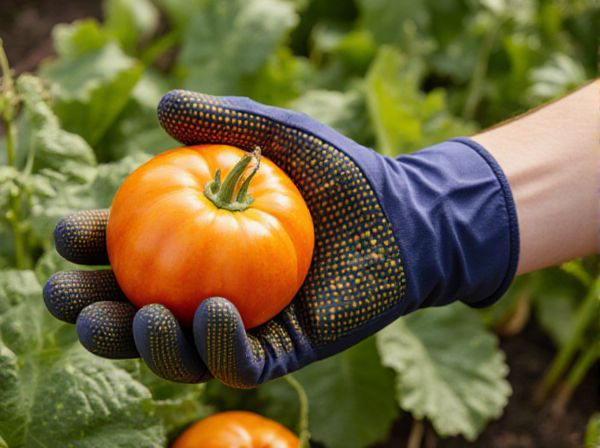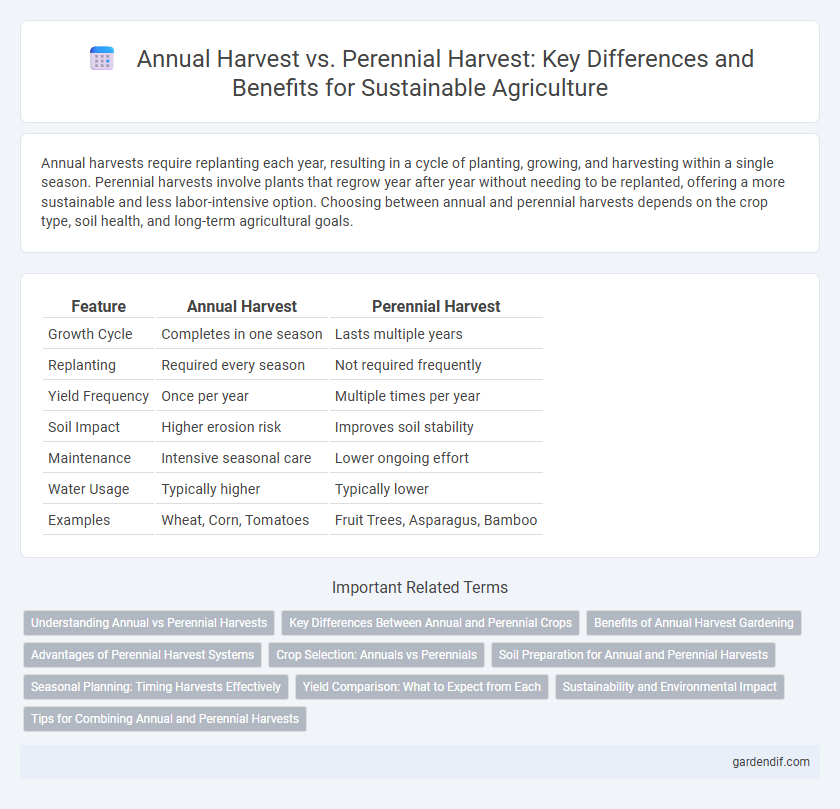
Annual Harvest vs Perennial Harvest Illustration
Annual harvests require replanting each year, resulting in a cycle of planting, growing, and harvesting within a single season. Perennial harvests involve plants that regrow year after year without needing to be replanted, offering a more sustainable and less labor-intensive option. Choosing between annual and perennial harvests depends on the crop type, soil health, and long-term agricultural goals.
Table of Comparison
| Feature | Annual Harvest | Perennial Harvest |
|---|---|---|
| Growth Cycle | Completes in one season | Lasts multiple years |
| Replanting | Required every season | Not required frequently |
| Yield Frequency | Once per year | Multiple times per year |
| Soil Impact | Higher erosion risk | Improves soil stability |
| Maintenance | Intensive seasonal care | Lower ongoing effort |
| Water Usage | Typically higher | Typically lower |
| Examples | Wheat, Corn, Tomatoes | Fruit Trees, Asparagus, Bamboo |
Understanding Annual vs Perennial Harvests
Annual harvests involve crops that complete their life cycle within a single growing season, requiring replanting each year, which typically results in higher yields but increased labor and resource inputs annually. Perennial harvests come from plants that live for multiple years, allowing repeated harvesting without replanting and promoting soil stability and reduced erosion, making them more sustainable and resource-efficient over time. Understanding the differences between annual and perennial harvests aids in optimizing agricultural planning, balancing immediate production needs with long-term environmental benefits.
Key Differences Between Annual and Perennial Crops
Annual crops complete their life cycle in a single growing season, requiring replanting each year, while perennial crops live for multiple years and can be harvested repeatedly without replanting. Annuals often produce higher yields in a shorter time frame, making them suitable for intensive farming, whereas perennials contribute to soil health, reduce erosion, and lower long-term labor and input costs. The root systems of perennials are deeper and more extensive, enhancing water retention and nutrient uptake compared to the typically shallower roots of annuals.
Benefits of Annual Harvest Gardening
Annual harvest gardening allows for faster crop rotation, improving soil health by reducing pest and disease buildup. It enables gardeners to grow a diverse range of vegetables and fruits each season, maximizing yield within a single year. This method also provides flexibility to adjust planting based on climate conditions and market demand, ensuring consistent food production.
Advantages of Perennial Harvest Systems
Perennial harvest systems offer enhanced soil stability and reduced erosion due to their deep, extensive root networks, which improve water retention and nutrient cycling. These systems provide continuous yields over multiple years without the need for annual replanting, leading to lower labor and input costs while promoting biodiversity. By supporting long-term ecosystem health, perennial harvests contribute to sustainable agricultural practices and climate resilience.
Crop Selection: Annuals vs Perennials
Annual crops like wheat, corn, and soybeans complete their life cycle in one growing season, requiring replanting each year, which can lead to soil nutrient depletion. Perennial crops such as asparagus, rhubarb, and certain berry bushes grow back year after year without replanting, promoting soil stability and reducing erosion. Selecting crops based on their growth cycle impacts long-term farm sustainability, water usage, and labor demands.
Soil Preparation for Annual and Perennial Harvests
Soil preparation for annual harvests involves deep tilling and nutrient replenishment to support rapid crop growth and frequent planting cycles. Perennial harvests require minimal soil disturbance, emphasizing organic matter retention and soil structure preservation to sustain long-term root systems. Effective soil management enhances productivity by tailoring practices to the specific needs of annual versus perennial crops.
Seasonal Planning: Timing Harvests Effectively
Annual harvests require precise timing within a single growing season to maximize yield and avoid crop loss, making seasonal planning critical for success. Perennial harvests offer more flexibility since plants produce across multiple years, but effective timing still ensures peak productivity and resource optimization. Strategic scheduling based on crop type, climate conditions, and market demand enhances harvest efficiency and profitability.
Yield Comparison: What to Expect from Each
Annual harvests typically produce higher yields within a single growing season due to rapid growth and concentrated fruiting periods, ideal for crops like wheat and corn. Perennial harvests offer consistent yields over multiple years with less replanting effort, benefiting crops such as grapes and apples, though individual season yields may be lower compared to annuals. Farmers must balance short-term yield spikes from annuals against sustainable, long-term production reliability provided by perennials.
Sustainability and Environmental Impact
Annual harvests require replanting each year, leading to increased soil disturbance, higher water consumption, and greater reliance on synthetic fertilizers and pesticides, which can contribute to environmental degradation. Perennial harvests, with deep root systems and longer growth cycles, enhance soil stability, reduce erosion, and improve carbon sequestration, supporting sustainable agriculture and biodiversity. The long-term environmental benefits of perennials make them a more sustainable choice compared to the intensive resource demands of annual crops.
Tips for Combining Annual and Perennial Harvests
Combining annual and perennial harvests maximizes garden productivity by staggering planting and harvesting times, ensuring continuous food supply throughout the growing season. Select complementary crops such as fast-growing annuals like lettuce alongside long-term perennials like asparagus to optimize space and nutrient use. Incorporate crop rotation and interplanting strategies to maintain soil health and reduce pest pressure, enhancing overall yield and sustainability.
Annual Harvest vs Perennial Harvest Infographic

 gardendif.com
gardendif.com